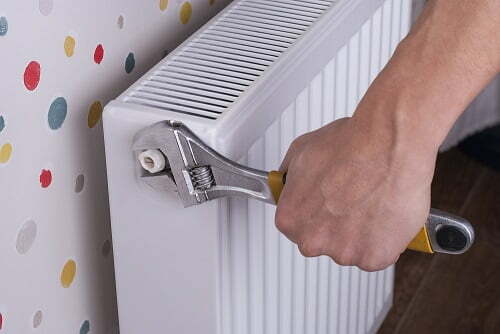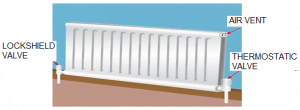
It will take no more than 25 minutes to replace the same size and model of radiator especially if you are going to be using the same radiator valves and wall brackets, please see below:
1. Turn off the valves to isolate the radiator from the heating system
Your first step is to turn off the central heating boiler and allow the water in the radiator to cool.
- At one end of the radiator there is a manual lock shield valve, turn this to the off position
You may have a thermostatic valve or manual valve at the other end, make sure it is also completely turned off and not just turned to the frost setting which can pass water.
Figure 1

2. Draining water from the old radiator
- Place a bowl or bucket under the manual control valve.
- Grip the body of the valve with one adjustable wrench. Hold it steady while you use another wrench to gently loosen the nut that connects the radiator valve to the radiator (fig. 2).
- Now you need to vent the radiator of air to break the vacuum inside and allow the water to flow out of the control valve. Do this by opening the bleed valve at the top with a radiator key (fig. 3).
- Hold a towel under the bleed valve to catch any drips.
- Keep draining the water out of the control valve end of the radiator until the flow stops.
Figure 2

3. Removing the old radiator
- Once the radiator is drained, loosen and undo the large nut that connects each of the valves to the adaptor in the radiator.
- You may have to gently push the central heating pipes and valves outwards to free the connections. (fig. 4).
- Lift the radiator upwards to remove it from the wall brackets. (fig. 4).
- Close the bleed valve with the radiator key (fig. 3).
- There’ll usually be some water left in the bottom of your radiator or towel rail, so tilt it to one side and drain this into a bucket.
- Place the radiator on old towels or sheets.
Figure 3 (left) and 4 (right)
4. Replacing your radiator
- When you replace your old radiator with the same size, style and model the brackets and pipework should connect up exactly.
- Reconnect the valve tails into the radiator
- Reconnect the large nuts on each valve
- Open up the flow into the radiator while bleeding air out of the vent
- Once the air is gone and water comes out of the vent, close the vent and open the lock shield valve.
- Turn the boiler back on and check for leaks.



